In this tutorial you'll learn what are the CSS pseudo classes and pseudo elements and how they are used.
CSS Pseudo-Classes
A pseudo-class is used to define a special state of an element.
For example, it can be used to:
- Style an element when a user hovers over it
- Style visited and unvisited links differently
- Style an element when it receives focus
Syntax
The syntax for pseudo-classes is as follows.
selector:pseudo-class {
property: value;
}Pseudo-classes are defined using a single colon (:) in CSS.
HTML Links Pseudo-classes
You can style different states of the HTML link elements in a web page in various ways by using pseudo classes as shown below:
/* Unvisited link will display in blue color */
a:link {
color: blue;
}
/* visited link will display in purple color */
a:visited {
color: purple;
}
/* Mouse over link will display in red color */
a:hover {
color: red;
}
/* Selected link will display in black color */
a:active {
color: black;
}Note: In your CSS, a:hover must appear after a:link and a:visited to work properly. Similarly, a:active must come after a:hover to be effective. Pseudo-class names are not case-sensitive.
Pseudo-Classes and HTML Classes
Pseudo-classes can be combined with HTML classes as shown below:
a.footer-links:hover {
color: grey;
}Hover on <div>
Here’s an example of using the :hover pseudo-class on a <div> element:
div:hover {
background-color: lightblue;
}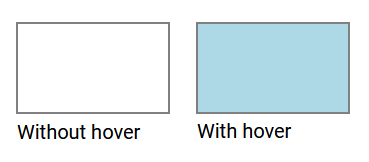
Show Text on Hover
Hover over a <div> element to display a <p> element (text):
p {
display: none;
}
div:hover p {
display: block;
}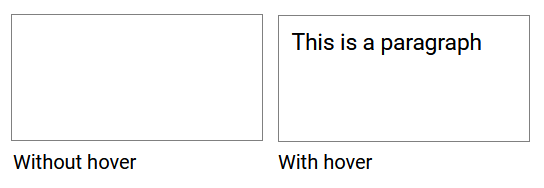
The :first-child Pseudo-Class
The :first-child pseudo-class selects an element that is the first child of its parent.
In the following example, the selector targets any <p> element that is the first child of its parent element.
p:first-child {
color: red;
}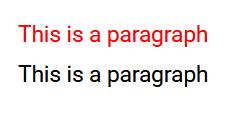
The :first-of-type Pseudo-Class
The :first-of-type pseudo class selects the first instance of the HTML element within the parent element.
In the following example, the selector targets the first <p> element within each <div> element.
div p:first-of-type {
color: red;
}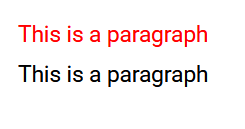
In the following example, the CSS selector targets all <span> elements within those <p> elements that are the first child of their parent.
p:first-of-type span {
color: darkblue;
}
The :lang Pseudo-class
The :lang pseudo-class enables you to apply specific styles based on language.
In the example below, :lang is used to set the color for <span> elements when lang="ru" (Russian).
span:lang(ru) {
color: blue;
}<p>"Some text" in Russian:<span lang="ru">Немного текста</span></p>The preview of above CSS will look like this:

CSS Pseudo-Elements
A CSS pseudo-element is used to apply styles to specific parts of an element. For example, it can be used to:
- Style the first letter or first line of an element
- Insert content before or after the existing content of an element
Syntax
The syntax for using pseudo-elements.
selector::pseudo-element {
property: value;
}In CSS3, the double colon (::) is used for pseudo-elements to distinguish them from pseudo-classes, which use a single colon (:).
In CSS2 and CSS1, the single-colon syntax was used for both pseudo-classes and pseudo-elements. For backward compatibility, the single-colon syntax is still acceptable for pseudo-elements defined in CSS2 and CSS1.
The ::first-line Pseudo-Element
The ::first-line pseudo-element applies a special style to the first line of text.
In the example below, the first line of text in all <p> elements is styled:
p::first-line {
color: red;
font-variant: small-caps;
font-weight: bold;
}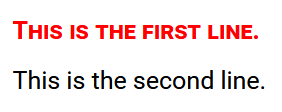
Note: The ::first-line pseudo-element can only be used with block-level elements.
The following properties can be applied to the ::first-line pseudo-element:
- Font properties
- Color properties
- Background properties
- Word spacing
- Letter spacing
- Text decoration
- Vertical alignment
- Text transform
- Line height
- Clear
The ::first-letter Pseudo-Element
The ::first-letter pseudo-element applies a special style to the first letter of a text.
Here is an example that styles the first letter of text in all <p> elements:
p::first-letter {
color: red;
font-size: xx-large;
} 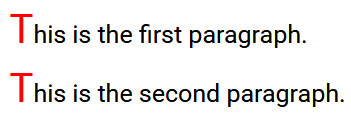
Note: The ::first-letter pseudo-element can only be applied to block-level elements.
The following properties can be applied to the ::first-letter pseudo- element:
- font properties
- color properties
- background properties
- margin properties
- padding properties
- border properties
- text-decoration
- vertical-align (only if "float" is "none")
- text-transform
- line-height
- float
- clear
Pseudo-Elements and HTML Classes
Pseudo-elements can be combined with HTML classes:
p.intro::first-letter {
color: red;
font-size: 100%;
}Multiple Pseudo-Elements
Several pseudo-elements can also be combined.
In the following example, the first letter of a paragraph will be blue, in a large font size. The rest of the first line will be orange. The rest of the paragraph will have the default font size and color.
p::first-letter {
color: blue;
font-size: 32px;
}
p::first-line {
color: orange;
}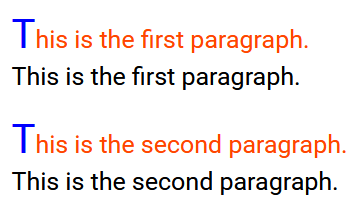
The ::before Pseudo-Element
The ::before pseudo-element can be used to insert some content before the content of an element.
The following example inserts an icon before the content of each <h1> element.
h1::before {
content: url('h1-icon.png');
}
The ::after Pseudo-Element
The ::after pseudo-element can be used to insert some content after the content of an element.
The following example inserts an icon after the content of each <h1> element.
h1::after {
content: url('h1-icon.png');
}
The ::marker Pseudo-Element
The ::marker pseudo-element selects the markers of list items. The following example customizes the appearance of list item markers.
::marker {
color: blue;
}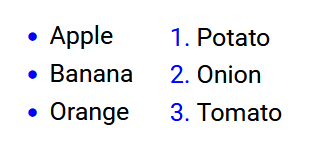
The ::selection Pseudo-Element
The ::selection pseudo-element matches the portion of an element that is selected by a user. The following CSS properties can be applied to ::selection:
- color
- background
- outline
::selection {
color: green;
background: yellow;
}
